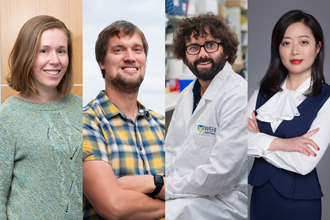Wang XS, Cotton TR, Trevelyan SJ, Richardson LW, Lee WT, Silke J, Lechtenberg BC. The unifying catalytic mechanism of the RING-between-RING E3 ubiquitin ligase family. Nature Communications. 2023;14(1):10.1038/s41467-023-35871-z
Cotton TR, Cobbold SA, Bernardini JP, Richardson LW, Wang XS, Lechtenberg BC. Structural basis of K63-ubiquitin chain formation by the Gordon-Holmes syndrome RBR E3 ubiquitin ligase RNF216. Molecular Cell. 2022;82(3):10.1016/j.molcel.2021.12.005
Lechtenberg BC, Rajput A, Sanishvili R, Dobaczewska MK, Ware CF, Mace PD, Riedl SJ. Structure of a HOIP/E2~ubiquitin complex reveals RBR E3 ligase mechanism and regulation. Nature. 2016;529(7587):10.1038/nature16511
Wang XS, Jiou J, Cerra A, Cobbold SA, Jochem M, Mak KHT, Corcilius L, Silke J, Payne RJ, Goddard-Borger ED, Komander D, Lechtenberg BC. The RBR E3 ubiquitin ligase HOIL-1 can ubiquitinate diverse non-protein substrates in vitro. Life Science Alliance. 2025;8(6):10.26508/lsa.202503243
M. Bader S, Calleja DJ, Devine SM, Kuchel NW, Lu BGC, Wu X, Birkinshaw RW, Bhandari R, Loi K, Volpe R, Khakham Y, Au AE, Blackmore TR, Mackiewicz L, Dayton M, Schaefer J, Scherer L, Stock AT, Cooney JP, Schoffer K, Maluenda A, Kleeman EA, Davidson KC, Allison CC, Ebert G, Chen G, Katneni K, Klemm TA, Nachbur U, Georgy SR, Czabotar PE, Hannan AJ, Putoczki TL, Tanzer M, Pellegrini M, Lechtenberg BC, Charman SA, Call MJ, Mitchell JP, Lowes KN, Lessene G, Doerflinger M, Komander D. A novel PLpro inhibitor improves outcomes in a pre-clinical model of long COVID. Nature Communications. 2025;16(1):10.1038/s41467-025-57905-4
Matsumoto M, Gomez-Soler M, Lombardi S, Lechtenberg BC, Pasquale EB. Missense mutations of the ephrin receptor EPHA1 associated with Alzheimer’s disease disrupt receptor signaling functions. Journal of Biological Chemistry. 2025;301(2):10.1016/j.jbc.2024.108099
Lechtenberg BC, Komander D. Just how big is the ubiquitin system?. Nature Structural & Molecular Biology. 2024;31(2):10.1038/s41594-023-01208-z
Gomez-Soler M, Olson EJ, de la Torre ER, Zhao C, Lamberto I, Flood DT, Danho W, Lechtenberg BC, Riedl SJ, Dawson PE, Pasquale EB. Lipidation and PEGylation strategies to prolong the in vivo half-life of a nanomolar EphA4 receptor antagonist. European Journal of Medicinal Chemistry. 2023;262:10.1016/j.ejmech.2023.115876
Roy MJ, Surudoi M, Kropp A, Hou J, Dai W, Hardy JM, Liang L-Y, Cotton TR, Lechtenberg BC, Dite TA, Ma X, Daly RJ, Patel O, Lucet IS. Structural mapping of the PEAK pseudokinase interactome identifies 14-3-3 as a molecular switch regulating PEAK3/Crk signalling. Acta Crystallographica Section A: Foundations and advances. 2023;79(a2):10.1107/s2053273323086850
Roy MJ, Surudoi MG, Kropp A, Hou J, Dai W, Hardy JM, Liang L-Y, Cotton TR, Lechtenberg BC, Dite TA, Ma X, Daly RJ, Patel O, Lucet IS. Structural mapping of PEAK pseudokinase interactions identifies 14-3-3 as a molecular switch for PEAK3 signaling. Nature Communications. 2023;14(1):10.1038/s41467-023-38869-9




